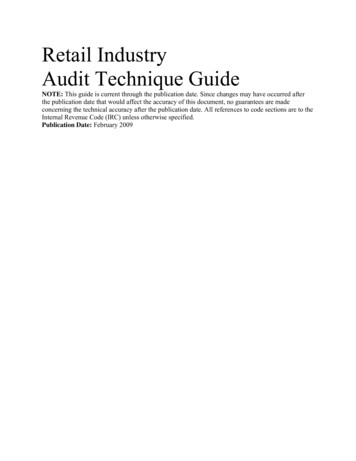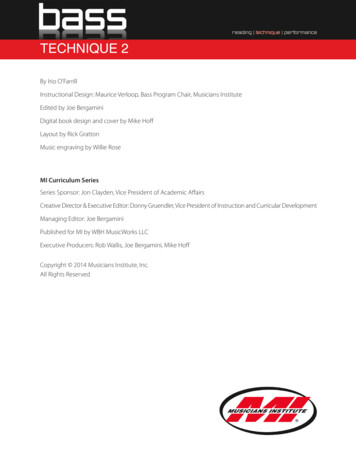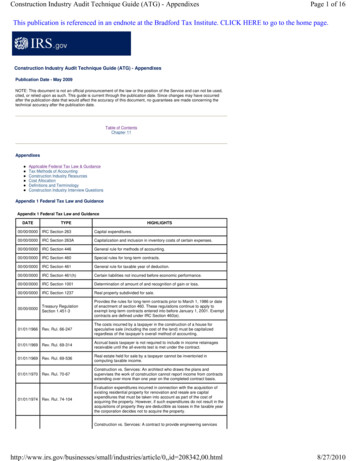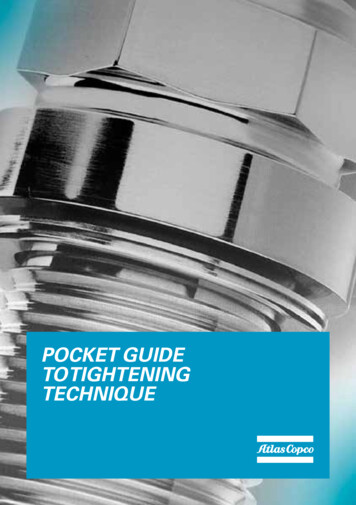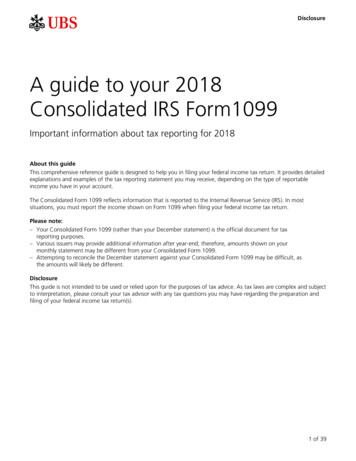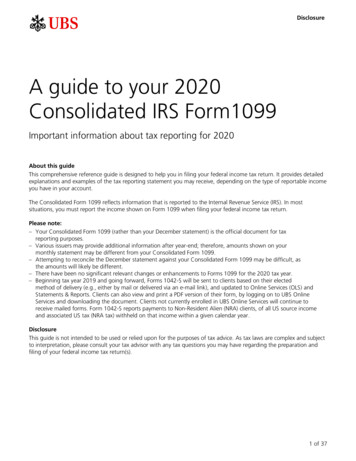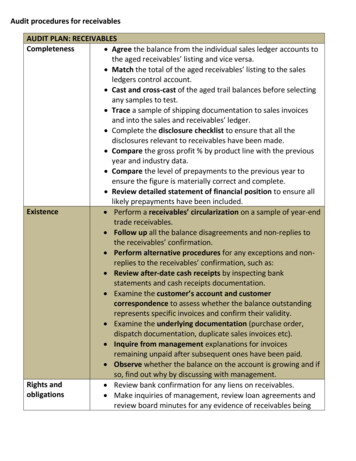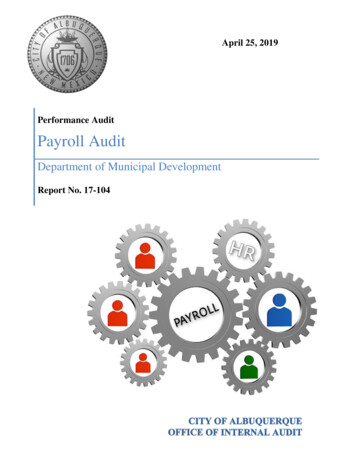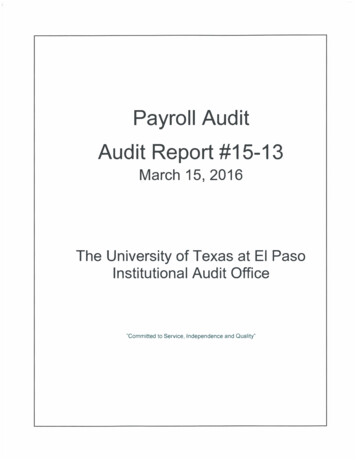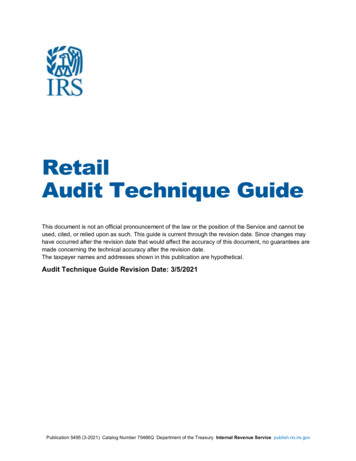
Transcription
RetailAudit Technique GuideThis document is not an official pronouncement of the law or the position of the Service and cannot beused, cited, or relied upon as such. This guide is current through the revision date. Since changes mayhave occurred after the revision date that would affect the accuracy of this document, no guarantees aremade concerning the technical accuracy after the revision date.The taxpayer names and addresses shown in this publication are hypothetical.Audit Technique Guide Revision Date: 3/5/2021Publication 5495 (3-2021) Catalog Number 75466Q Department of the Treasury Internal Revenue Service publish.no.irs.gov
Table of ContentsI. Overview. 19A. Background / History . 19A.1. What Retailers Do. 19A.2. Demographics of the Retail Industry . 20A.3. Retail Entities. 20B. Relevant Terms . 20II. Chapter 2: Examination Techniques & Job Aids . 23A. Initial Interview . 23A.1. Business Operations . 24A.2. Cash-on-Hand . 24A.3. Personal Expenditures . 24B. Tour of the Business Site . 24C. Information Document Request. 25D. Books and Records . 25E. Third Party Contacts . 26F. Income Issues . 262
F.1. Sources of Income/Receipts for Retailers . 26F.2. Target Profit Percentage. 27F.3. Vendor Rebates and Allowances . 27F.4. Credit and Chargebacks . 29F.5. Advance Payments - Gift Certificates and Gift Cards . 29F.6. Income from Service-Related Activities . 30F.7. Promotional Allowances. 30F.8. Prizes and Trips. 30F.9. Consignments . 31F.10. Sale of Accounts Receivables . 31F.11. Lottery . 31F.12. Vending Machines . 31F.13. Bartering . 32F.14. Cash Records . 32F.15. Analysis of Gross Receipts . 33F.16. In-Depth Examinations of Income (IRM 4.10.4.5) . 34F.17. Source and Application of Funds Method (IRM 4.10.4.6.3)35F.18. Bank Deposit and Cash Expenditures Method (IRM3
4.10.4.6.4) . 36F.19. Markup Method (IRM 4.10.4.6.5) . 37F.20. Unit and Volume Method (IRM 4.10.4.6.6) . 37F.21. Net Worth Method (IRM 4.10.4.6.7) . 38G. Cost of Goods Sold . 38G.1. Personal Consumption of Inventory . 38G.2. Retail Inventory Method (RIM) . 39G.3. Uniform Capitalization Rules (UNICAP) . 42G.4. Last In, First Out (LIFO) . 42G.5. Stock Ledger (Inventory) . 43G.6. Point of Sale Perpetual Inventory Control System. 43G.7. Inventory Purchases . 43H. Expenses . 43H.1. Franchise Fees . 44H.2. Cooperative Advertising . 45H.3. Charitable Contributions and Promotions . 45H.4. Accruals . 47H.5. Covenants Not to Compete . 47I. Depreciation and Cost Segregation Studies . 474
I.1. Depreciation and Cost Segregation Overview . 47I.2. Cost Segregation ATG . 48I.3. Suspended Acoustical Ceilings . 49I.4. Heating, Ventilating and Air Conditioning (HVAC) . 49J. Other Potential Income Tax Issues . 49K. Excise Tax Issues . 50L. Employment Tax Issues/Information Returns . 50III. Chapter 3: Grocery Stores . 51A. Income . 51A.1. Food Product Sales - Sales Summary Report . 52A.2. Coupon Income . 52A.3. SNAP and WIC Income . 52A.4. Gift Cards and Certificates . 53A.5. Promotional Items . 53A.6. Vending Machines . 54A.7. Courtesy Account . 54A.8. Demonstrators . 54B. Cost of Goods/Inventory . 555
B.1. Retail Inventory Method (RIM) . 55B.2. Last In First Out (LIFO) Method . 56B.3. Vendor Allowances . 56B.4. Cooperative Advertising . 57B.5. Sales-Based (a/k/a scan-based) . 57B.6. Slotting (Shelving). 57B.7. Upfront Payments . 58C. Expenses . 59C.1. Advertising or Contribution . 59C.2. Depreciation. 59C.3. Domestic Production Activities Deduction (DPAD) . 59C.4. Donation of Inventoriable Goods . 60C.5. Franchise Fees . 60C.6. Reward Programs (Loyalty Points) . 61C.7. Store Remodeling Costs. 61C.8. Other Considerations. 61IV. Chapter 4: Electronic Business & Online Retail . 62A. Introduction . 62B. Identification of E-Business Cases . 62C. Interview Questions . 66C.1. E-Business Online Retail & Services Interview6
Questionnaire . 66D. Income . 68E. Cost of Goods Sold . 68F. Expenses . 69F.1. Business Start-Up Costs . 69F.2. Research & Experimental Expenditures and Credit. 69F.3. Website Development Costs . 70G. Other Potential Tax Issues . 71H. Glossary. 71V. Chapter 5: Retail Liquor Sales . 72A. Introduction . 72B. Income . 72B.1. Other Grocery Sales – Cigarettes, Snacks, Food & CandyItems . 72B.2. Check Cashing and Customers’ Payments on Account. 73C. Cost of Goods Sold . 73VI. Chapter 6 : Mobile Food Vendors . 73A. Introduction . 73B. Income . 73C. Cost of Goods Sold . 74D. Expenses . 74E. Glossary. 757
VII. Chapter 7: Gasoline Service Stations . 75A. Introduction . 75B. Initial Interview Questions . 75C. Income . 77C.1. Incentive Agreements . 77C.2. Imaging Reimbursement Payments- Income Issues. 77C.3. Oil Company . 80C.4. Food, Beverage, Cigarette Wholesalers . 80C.5. Parts Suppliers . 80C.6. State Certification & Inspection Information . 81C.7. State Sales Tax Records. 81C.8. Public Records . 81C.9. Indirect Methods. 81C.10. Other Exam Issues- Omitted Income . 82C.11. Surveys . 82D. Cost of Goods Sold . 83D.1. Shrinkage, Leakage, Theft, and Personal Use . 83D.2. Service Station Acquisition Payments . 84D.3. Liquidation/Accommodation Agreements, Security8
Agreements, Prepayment/Reserve Account Deposits . 84D.4. Rebates . 84D.5. Excise and Sales Taxes . 85E. Expenses . 85E.1. Rent Expense. 85E.2. Imaging Reimbursement Payments- Expense Issues . 85E.3. Environmental Clean-Up Costs . 86E.4. Fixed Asset & Depreciation Issues . 87E.5. Bonus Depreciation . 88F. Excise Tax Issues . 88F.1. Dyed Fuel . 88F.2. Blending . 88G. Useful Websites . 89H. Glossary. 89VIII.Chapter 8: Motor Vehicle Dealerships . 90A. Introduction . 90A.1. Impact of state regulation and state law . 91B. Records . 919
B.1. Car Jacket . 91B.2. Cash Receipts. 92B.3. Accounting records .
B.1. Retail Inventory Method (RIM). 55 B.2. Last In First Out (LIFO) Method . 56 B.3. Vendor Allowances . 56 B.4. Cooperative Advertising . 57 B.5. Sales-Based (a/k/a scan-based) . 57
